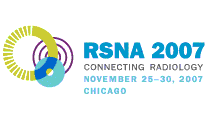
Abstract Archives of the RSNA, 2007
SSC19-08
Subendocardial Myocardial Fat in Myocardial Infarction
Scientific Papers
Presented on November 26, 2007
Presented as part of SSC19: Cardiac (CT)
Sungsoo Ahn MD, Presenter: Nothing to Disclose
Byoung Wook Choi MD, Abstract Co-Author: Nothing to Disclose
Young-Jin Kim, Abstract Co-Author: Nothing to Disclose
Jin Hur, Abstract Co-Author: Nothing to Disclose
Kyu Ok Choe MD, Abstract Co-Author: Nothing to Disclose
Kyung Jong Yoo, Abstract Co-Author: Nothing to Disclose
Recently, CT scans has been reported to incidentally detect some conspicuous myocardial fat (MF) in the left ventricular myocardium, which were related to myocardial infarction. We sought to systemically analyze myocardial fat in patients with myocardial infarction in relation to clinical information.
We enrolled 161 patients (men 127, mean age 60 years) who underwent CT coronary angiography and had previously been diagnosed as myocardial infarction. We performed non-enhanced CT (NECT) for calcium scoring and enhanced CT (CECT) for coronary angiography. Two radiologists determined presence of fat in myocardium in consensus with reviewing on NECT. We analyzed characteristics of MF and compared those and clinical information between the patients who had MF and those who did not.
MF was found in infarcted myocardium in 36 (22.4%) patients. All MF were located in subendocardial region. Transmural extent of MF measured in CECT was 0-25% of wall thickness in 13.9%, 25-50% in 69.4%, and 50-75% in 16.7%. Mean attenuation value of MF was -27.3HU (STD 23HU) in NECT. The incidence of MF increased in relation to infarct age; 9.1% within the first year after infarction, 20.7% during 2nd to 3rd years, 27% from 4th to 7th year, and 46.4% thereafter. ST elevation was significantly more frequent in patients with MF (78.3% vs 56.2%). Age, sex, incidence of Q wave, initial level of maximal CK-MB and troponin-T, degree of culprit artery stenoses, and number of diseased vessels in the patients with MF were not significantly different from those in patients without MF. Wall motion abnormality in the last follow-up echocardiography was greater in the patients with MF than in those without MF. Arrhythmogenic potency related to MF was not definite.
MF was found in infarcted myocardium more frequently in ST elevated infarction and older infarct age. Severer wall motion abnormality may be expected on the follow-up of infarcted myocardium if MF is seen on CT. Further investigation is warranted for ventricular remodeling and prognosis related to MF.
Conspicuous subendocardial myocardial fat can be found in infarcted myocardium more frequently in ST elevated infarction and older infarct age.
Ahn, S,
Choi, B,
Kim, Y,
Hur, J,
Choe, K,
Yoo, K,
Subendocardial Myocardial Fat in Myocardial Infarction. Radiological Society of North America 2007 Scientific Assembly and Annual Meeting, November 25 - November 30, 2007 ,Chicago IL.
http://archive.rsna.org/2007/5014816.html
Accessed September 23, 2025

